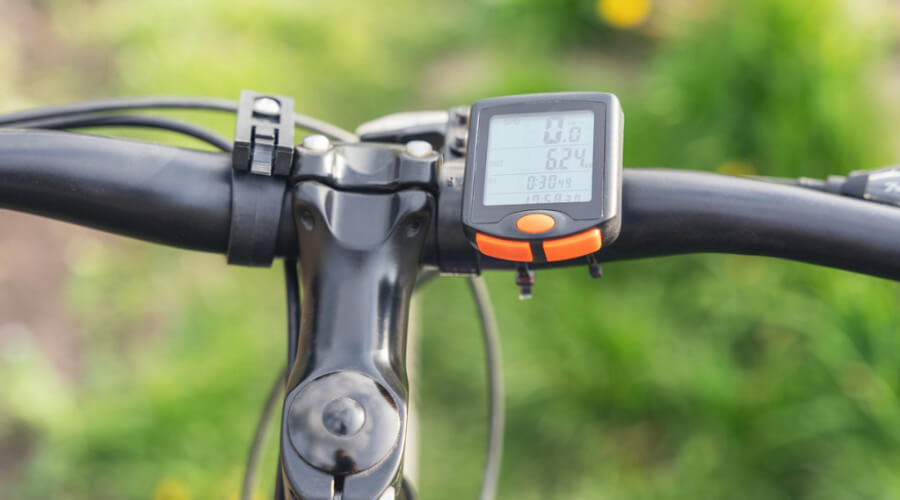Biking power meters have come a long way and have improved reliability and accuracy as their prices drop. The market has power meters for all types of bikes, from cheap to pro-level expensive, and there are numerous ways to mount them to the bike. A power meter works by measuring the force you apply when you peddle and convert the force to power, which is the energy use rate. It’s important to measure power because it clearly and directly indicates how hard the rider is cycling without the effects of environmental factors.
Different power meters can measure force at multiple locations on your bike with varying levels of complexity. The part where you measure the power can impact the value of energy that is being measured. Therefore, you need to know how to use the information that you receive from the power meter.
How Do Cycling Power Meters Work?

All types of power meters work by measuring the pedal stroke force against the bike’s resistance when it’s moving forward. The difference only occurs on the part where they measure it, for instance, the pedal, spider, or crank arm. However, all these parts essentially use a similar mechanism known as a strain gauge.
Power meter boxes use several strain gauges, which allow them to measure force at various points in the rotation of the crank. A strain gauge is typically attached to a solid piece like the crank arm or the spindle. When fixed at rigid places, the power meter can measure small deformations in the material when pedaling.
You can’t see when you stretch, torque, and bend the cranks, spiders, and axles when pedaling, but you are doing it, and because the strain gauge is quite sensitive, it will measure it. Manufacturers understand the amount of force needed to deform it at a specific amount. They utilize the data in calculating the power depending on how much the part is being deformed. The circuitry and software will then convert the data into a number transmittable through ANT+ and Bluetooth to the cycling computer. Moreover, most of them also transmit the rider’s cadence.
Should The Power Meter Be 100% Accurate?
Many brands claim their crank-based power meters have an accuracy of +/- 1% with a tolerance of about 2-3% for the affordable options. It’s tricky to answer whether the power meter should be 100% accurate because it doesn’t matter whether it is or not as long as you are sticking with the same one. Ensure that you buy a top-quality brand and product, and it will work just fine. Your only concern should be whether the one you will be buying will best fit your bike needs and budget.
No matter the type of power meter you buy, what matters is consistency. The best power meters are the ones used daily, and if you switch from one brand to the other, you will introduce variability that will make it hard to compare your training sessions accurately and track your progress.
How To Train With Power
There are numerous ways to train with power, and you don’t have t buy a power meter. If you don’t have enough cash or are unsure whether it has any benefits, you can train with power without the meter. However, if you can afford to purchase it, it is a worthy investment as it will come in handy when cycling. To start working with power when you have no power meter, you must be creative. You can begin by using a Wattbike or a similar indoor trainer to measure power in the gym. Most gyms have a Wattbike, and if you are a gym member, this could be an excellent way for you to engage in some power-based sessions. A turbo trainer is also another option for training with power, as most of them are calibrated so that they can convert your riding speed to power.
When training indoors, you must understand that the power measurement of your smart trainer will be different than the power measurement of your bike power. Therefore, if you are training seriously, you should consider putting your power meter-equipped bike on your trainer and using it for tracking performance as you depend on your smart trainer to regulate resistance or online avatars.
Should You Buy A Separate Right/Left Power Meter
As a rider, you want to have a 50/50 power balance between both legs, but some people may have a much more dominant and more assertive leg than the other. If you have a dual-sided power meter, it will help you know which leg is more robust.
Most power meters measure the output of your left leg. This is effective since the software doubles that number to provide an approximate total power output. The number is simple but very important.
A spindle-based power meter will only be able to measure the output of your left leg since only the left side forces can be transmitted through the piece. So, if the crank arm meter power has been installed in the left crank arm, it will only measure the output of the left leg.
The only disadvantage to having a single-leg power meter is that it will not show the difference between your legs. Because many people have a dominant leg, it’s essential to know which of your legs is weaker and by how much so you can get the data to help strengthen the weak leg and restore balance to your bike. Therefore, buying power meters with separate sensors on your right and left sides is the best option to deliver accurate power readings. That will be an excellent way to track your pedaling technique and measure recovery after injuries too.
Conclusion
A cycling power meter can help a rider take his conditioning and speed to the next level. A power meter is relatively easy to install and can be used with tri bikes and road bikes to increase training precision and improve speed. The logic of using a power meter is that a cyclist can only improve what he can measure; therefore, if you can afford it, it’s best to get a power meter for training.

